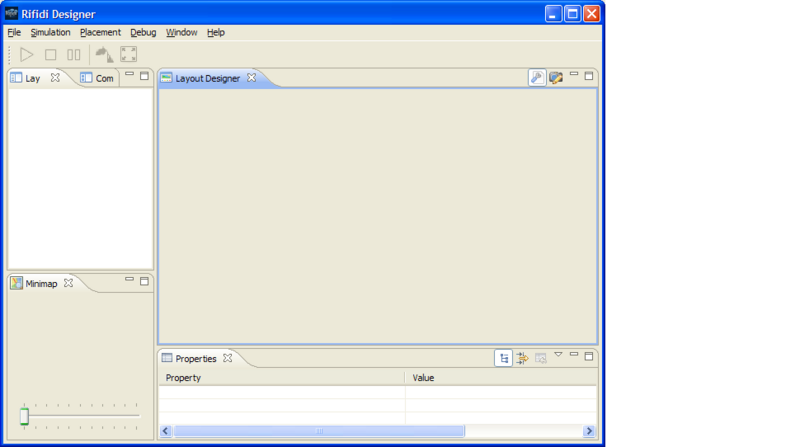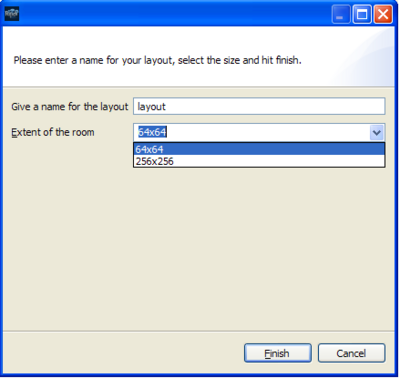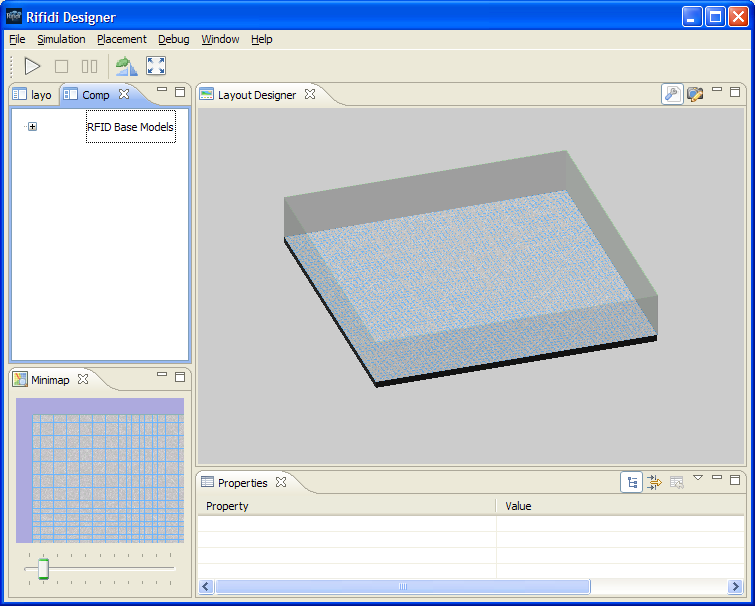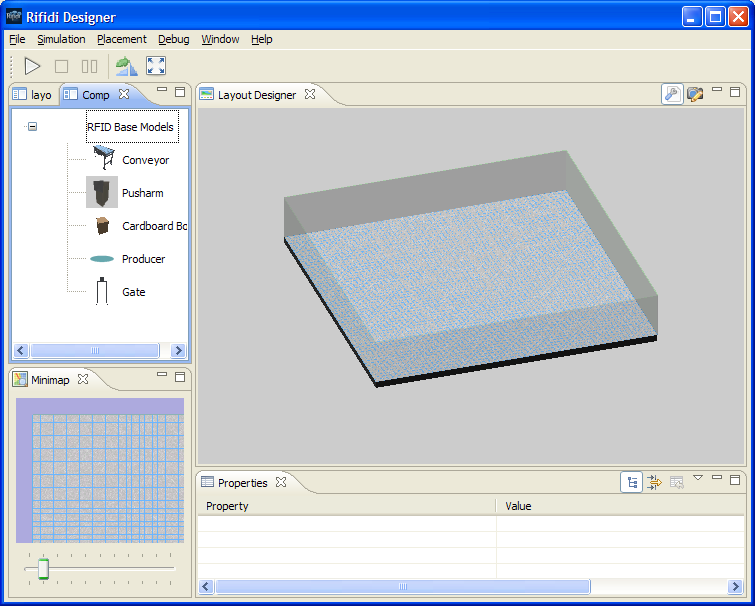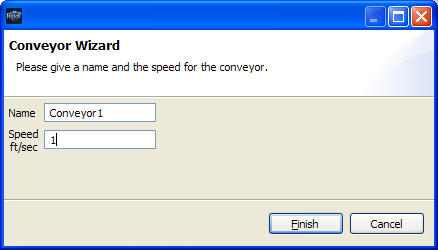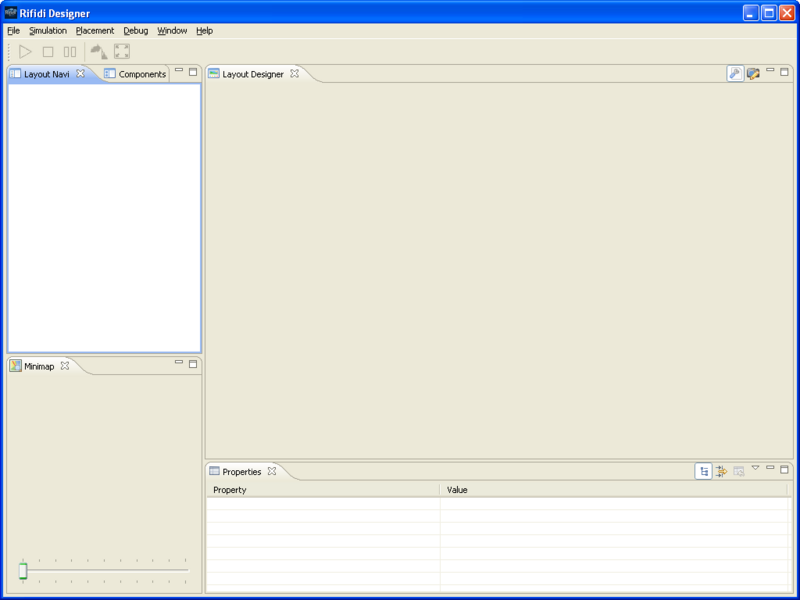Difference between revisions of "Designer User's Guide"
From RifidiWiki
(→Requirements) |
(→Requirements) |
||
| Line 3: | Line 3: | ||
=Requirements= | =Requirements= | ||
*Microsoft Windows 2000/XP/2003 or Linux (Ubuntu, Red Hat, SuSe) | *Microsoft Windows 2000/XP/2003 or Linux (Ubuntu, Red Hat, SuSe) | ||
| − | *Sun Java Runtime Environment 1. | + | *Sun Java Runtime Environment > 1.6 (J2SE 6.0) |
** If you are having trouble running Designer 1.0 or 1.1, please see [[Specifying JRE 5 |Workaround for JRE 1.6 Issue]] | ** If you are having trouble running Designer 1.0 or 1.1, please see [[Specifying JRE 5 |Workaround for JRE 1.6 Issue]] | ||
Revision as of 21:24, 28 April 2008
Contents
- 1 Requirements
- 2 Installation
- 3 Launching Rifidi Designer
- 4 Getting Started - Example Designer Simulation
- 4.1 Create Layout
- 4.2 Add a Conveyor
- 4.3 Add a Push Arm
- 4.4 Add a Gate
- 4.5 Add a Box Producer
- 4.6 Component Placement
- 4.7 Assign a Data Producer to a Producer component
- 4.8 Create a Group
- 4.9 Add Components to Group
- 4.10 Turn On Components
- 4.11 Start Simulation
- 4.12 Pause Simulation
- 4.13 Reset Simulation
- 4.14 Turn Off Components
- 4.15 Properties
- 4.16 Add Components to Group
- 5 Layouts
- 6 Components
- 7 Placement
- 8 Layout Navigation
- 9 MiniMap
- 10 Camera
- 11 Quickstart Video
Requirements
- Microsoft Windows 2000/XP/2003 or Linux (Ubuntu, Red Hat, SuSe)
- Sun Java Runtime Environment > 1.6 (J2SE 6.0)
- If you are having trouble running Designer 1.0 or 1.1, please see Workaround for JRE 1.6 Issue
Installation
Designer is completely written in Java so installation is very easy. Additionally, Designer is packaged in a standard installer.
- Download the latest version of Rifidi Emulator from http://sourceforge.net/projects/rifidi/
- Double click to run the install. Follow the on screen instructions.
Launching Rifidi Designer
- Windows Users: Simply click the shortcut located in the Rifidi folder in the Start Menu/Programs folder.
- Linux Users: Double click the executable file located in the installation directory.
Getting Started - Example Designer Simulation
Create Layout
- Once the program is loaded, the main UI will be present.
- To create a new layout, click the 'file' and 'new layout'.
- Enter in a layout name, select size of the room (64x64 or 256x256 square feet) and click 'Finish'.
- A new empty layout will be displayed in the UI ready for use
Add a Conveyor
- Click on the 'Components' Tab to view the library of all available components to add to a layout.
- If the list is not expanded already, Click on the '+' next to RFID Base Models to expand the list.
- Highlight the 'Conveyor' component and drag and drop to the 'Layout Designer'
- Enter a name for the component and the feet per second. (Example 1 ft/sec)
- You will now see the component displayed in the 'Layout Designer'. Note: For placement refer to the Component Placement Section
Add a Push Arm
- Click on the 'Components' Tab to view the library of all available components to add to a layout.
- If the list is not expanded already, Click on the '+' next to RFID Base Models to expand the list.
- Highlight the 'Push Arm' component and drag and drop to the 'Layout Designer'
- Enter a name for the component, the seconds per push and click 'Finish'. (Example: 1 sec/push)
- You will now see the component displayed in the 'Layout Designer'. Note: For placement refer to the Component Placement Section
Add a Gate
- Click on the 'Components' Tab to view the library of all available components to add to a layout.
- If the list is not expanded already, Click on the '+' next to RFID Base Models to expand the list.
- Highlight the 'Gate' component and drag and drop to the 'Layout Designer'
- Enter a name for the component, select a reader type and click 'Next'.
- Enter a name for the reader and click 'Finish'.
- You will now see the component displayed in the 'Layout Designer'. Note: For placement refer to the Component Placement Section
Add a Box Producer
- Click on the 'Components' Tab to view the library of all available components to add to a layout.
- If the list is not expanded already, Click on the '+' next to RFID Base Models to expand the list.
- Highlight the 'Producer' component and drag and drop to the 'Layout Designer'
- Enter a name for the component, seconds per box and click 'Finish'. (Example: 5 sec/box)
- You will now see the component displayed in the 'Layout Designer'. Note: For placement refer to the Component Placement Section
Component Placement
Conveyor Placement
- In the Layout Designer View, click on the conveyor. Note: Yellow arrows will show the direction of the conveyor
- Move the conveyor to the desired location by holding the left mouse button down. Note: The area below the component will be highlighted in green when placement is valid and red when placement is invalid.
- Release the left mouse button once the desired location has been reached.
- If placement is valid the component will move to the new location and if placement is invalid the component will move to the prior valid location
Box Producer Placement
- In the Layout Designer View, click on the Box Producer.
- Move the producer to the desired location by holding the left mouse button down. Note: The area below the component will be highlighted.
- Once the producer is over the end of the conveyor, release the left mouse button to finish placement.
Push Arm Placement
- In the Layout Designer View, click on the Push Arm.
- Move the gate to the desired location by holding the left mouse button down. Note: The area below the component will be highlighted.
- Once the push arm is next to the right end of the conveyor, release the left mouse button.
- To finalize the placement, verify the push arm is pointed in the direction to push over the conveyor (Look for shaded area to be over conveyor). If not then you can rotate the component by 90 degrees by clicking on the component and then clicking on the rotate 90 degrees button in the toolbar. Note: Click twice to turn the component in the opposite direction.
Gate Placement
- In the Layout Designer View, click on the Gate.
- Verify the space between the gate's legs can fit over the conveyor based on the conveyor's placement. If not then click on the gate and rotate 90 degrees by clicking on the 90 degree rotate button in the toolbar.
- Move the gate to the desired location by holding the left mouse button down. Note: The area below the component will be highlighted in green when placement is valid and red when placement is invalid.
- Once the gate is over the center of the conveyor, release the left mouse button.
Assign a Data Producer to a Producer component
- Click on the Layout Navigator tab.
- Click on the '+' next to Ungrouped Components to expand the ungrouped components list if not expanded already.
- Click on the '+' next to Data Producer to expand the data producer list if not expanded already.
- In the Data Producer list click on the desired tag data to be associated with the box producer. (Example: DOD tags)
- Hold the left mouse button down on the desired data producer and drag and drop onto the Box Producer located in the ungrouped components list.
- You have now associated a Data Producer to the Box Producer which is a necessary step for the simulation to generate the desired tag data format.
Create a Group
- Click on the Layout Navigator tab.
- Right click on Grouped Components
- In the right click menu, click on create group
- In the create group wizard, enter in a group name (example: group1)
- You will now see the new group listed under Grouped Components
Add Components to Group
- Click on the Layout Navigator tab.
- Click on the '+' next to Ungrouped Components to expand the ungrouped components list if not expanded already.
- Click on the '+' next to Grouped Components to expand the grouped list if not expanded already.
- In the Ungrouped Components list, click on the conveyor component (Example: conveyor1).
- Hold the left mouse button down on the conveyor component and drag and drop into the Group (Example: group1)
- Repeat steps 2 - 4 for each or the remaining ungrouped components
- Once all the steps have been completed, you will now have all the components assigned to a group. (Example: group1) Now you can move the components around in a group in the Layout Designer instead of having to move each component seperately. There are other benefits of groups which will be described in later sections.
Turn On Components
There are two ways to turn on components:
- Click on the Layout Navigator tab if not already selected.
- Click on the '+' next to Grouped Components to expand the grouped list if not expanded already.
- Click on the '+' next to the group name (Example: group1) to expand the group if not expanded already.
- Right click on the conveyor component
- In the conveyor component right click menu, click on turn On
- Repeat steps 3-4 for each component in the group
or the short cut is to:
- Click on the Layout Navigator tab if not already selected.
- Click on the '+' next to Grouped Components to expand the grouped list if not expanded already.
- Click on the '+' next to the group name (Example: group1) to expand the group if not expanded already.
- Right click on group (Example: group1)
- In the group right click menu, click on Turn On
- This will Turn On all the components assigned to tha group
You can now connect to the virtual reader (Alien, AWID, Symbol, LLRP) you created with a client such as telnet, client library, middleware or EdgeServer.
Start Simulation
- On the Designer Toolbar, you can now click on the play button to start the simultaion
- Once you start the simultaion you should now see boxes being produced and the conveyor and push arm moving at their defined rates.
- The client connected to the virtual reader should now report tags as the boxes pass through the gate's aetenna.
Pause Simulation
- On the Designer Toolbar, you can now click on the Pause button to start the simultaion
- Once you pause the simultaion you should now see boxes being produced and the conveyor and push arm moving pause, left in the previous state.
- The client connected to the virtual reader will continue to be connected.
Reset Simulation
- On the Designer Toolbar, you can now click on the reset button to start the simultaion
- Once you reset the simultaion you should now see boxes being produced, the conveyor and push arm moving be reset
- The client connected to the virtual reader will continue to be connected.
Turn Off Components
There are two ways to Turn Off components:
- Click on the Layout Navigator tab if not already selected.
- Click on the '+' next to Grouped Components to expand the grouped list if not expanded already.
- Click on the '+' next to the group name (Example: group1) to expand the group if not expanded already.
- Right click on the conveyor component
- In the conveyor component right click menu, click on Turn Off
- Repeat steps 3-4 for each component in the group
or the short cut is to:
- Click on the Layout Navigator tab if not already selected.
- Click on the '+' next to Grouped Components to expand the grouped list if not expanded already.
- Click on the '+' next to the group name (Example: group1) to expand the group if not expanded already.
- Right click on group (Example: group1)
- In the group right click menu, click on Turn Off
- This will Turn Off all the components assigned to the group
The client should now disconnect from the virtual reader as if the device has been powered off
Properties
Edit Conveyor Speed
Add Components to Group
- Click on the Layout Navigator tab.
- Click on the '+' next to Grouped Components to expand the grouped list if not expanded already.
- Click on the '+' next to the group (Example: groups1) to expand the assigned grouped component list if not expanded already.
- Click on the conveyor component.
- At the bottom below the Layout Designer view you will now see the conveyor component's property view.
- Click on the speed property and change the value.
- The next time you Turn On the components (if not on already) and play the simulation you will see the new speed.
Edit Box Producer Rate
- Click on the Layout Navigator tab.
- Click on the '+' next to Grouped Components to expand the grouped list if not expanded already.
- Click on the '+' next to the group (Example: groups1) to expand the assigned grouped component list if not expanded already.
- Click on the box producer component.
- At the bottom below the Layout Designer view you will now see the box producer component's property view.
- Click on the rate property and change the value.
- The next time you Turn On the components (if not on already) and play the simulation you will see the new rate.
Layouts
Create Layout
- Once the program is loaded, the main UI will be present.
- To create a new layout, click the 'file' and 'new layout'.
- Enter in a layout name, select size of the room (64x64 or 256x256 square feet) and click 'Finish'.
- A new empty layout will be displayed in the UI ready for use
Open Layout
- Once the program is loaded, the main UI will be present.
Components
Turn on Components
Turn off Components
Rename Components
Delete Components
Placement
Moving Components
Rotating 90 Degrees
UnGrouped Components
Grouped Components
Create Group
Add Components
Rename Group
Delete Group
Generated Components
Data Producers
MiniMap
Zoom in/Zoom out
Camera
Camera Views
Zoom in/Zoom out
Quickstart Video
A video of these installation steps can be seen here: http://www.rifidi.org/rifidipackage/rif_out.html
